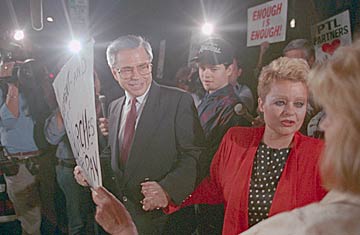
October 03, 1989: PTL founder Jim Bakker (left), his son, Jamie, (center) and wife, Tammy Faye Bakker, greet supporters as they leave federal court in Charlotte
(8 of 8)
To date, however, efforts at self-policing in gospel TV have failed miserably. The Evangelical Council for Financial Accountability of Washington monitors the ethical performance of agencies independent of church control and gives them a seal of approval. But its leader, the Rev. Arthur Borden, admits that loss of such accreditation has no impact on an agency. Of the biggest TV evangelists, only Billy Graham, who does not have a weekly series, is a member in good standing. The National Religious Broadcasters, to which most of the big operations belong, is toughening its ethical code and creating a voluntary agency to accredit broadcasters' ethics.
The need for such measures is an obvious indication of how far the independent entrepreneurs of television-based conglomerates have strayed from ordinary church life. The local Protestant congregation, observes Church Historian Martin Marty of the University of Chicago, "has to account for every penny it takes in. The treasurer lives next door to you. You all get to vote on the budget." By contrast, many televangelists are accountable only to themselves and to cozy boards of admirers.
Will the current furor weaken the evangelical movement, which has gained enormous impact and visibility over the past two decades? Sociologist James Davison Hunter of the University of Virginia thinks not. "It is very much a populist movement that derives its strength from the vision of reality it holds and an expansive set of institutions which sustain that vision," he observes. "The TV ministry is a small part of this. A visible part, but a small part."
The Rev. Billy Melvin, executive director of the National Association of Evangelicals, argues that his movement -- media portrayals to the contrary -- consists not of star preachers but of tens of thousands of churches across the country that "plug in, day in and day out." Perhaps last week's theatrics provide a useful reminder that the heart of Evangelicalism can never be found on the artificial "Main Street USA" of a theme park but only on the many real Main Streets, however simple and unglamorous, that traverse America.
